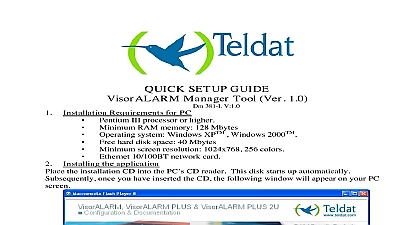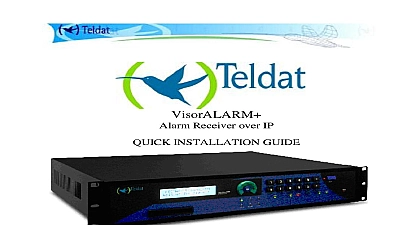Silent Knight Teldat Dm380 Iv3 VisorALARM Manager Quick Guide

File Preview
Click below to download for free
Click below to download for free
File Data
| Name | silent-knight-teldat-dm380-iv3-visoralarm-manager-quick-guide-0593871246.pdf |
|---|---|
| Type | |
| Size | 1.85 MB |
| Downloads |
Text Preview
VisorALARM Manager Application Quick Guide 1.3 380 I V 3.0 Requirements PC III processor or higher Minimum RAM memory 128 Mbytes Operating system Windows XPTM Windows 2000TM Minimum screen resolution 1024x768 256 colors hard disk space 40 Mbytes 10 100BT network card VisorALARM Check that the VisorALARM firmware release is 10.6.19.0.3 or higher Executing VisorALARM Manager and connecting to a VisorALARM executing the VisorALARM Manager application you need IP connectivity between PC and VisorALARM the steps required to achieve connectivity are described in the Quick Setup Guide initial application screen is as follows 1 the IP address for the VisorALARM you wish to access on this screen the connection is established you need to authenticate with the VisorALARM Manager Quick Guide DM380 I 3.0 2 the user and device password in the above screen authentication has completed the application main screen appears 3 Manager Quick Guide DM380 I 3.0 Reading the VisorALARM Configuration get or refresh the actual device configuration click on the configuration device This is shown in the following figure 4 first time that the VisorALARM Manager connects to the device this is done Modifying the VisorALARM general parameters Parameters tab shown in Fig 3 shows the VisorALARM parameters To any of these change the value for the required parameter and then click on the button see Fig 3 to save the change in the VisorALARM If you want to change parameters at the same time click on the button once you have executed all changes When the updating process has finished the program will ask you to restart the device Press to restart the equipment so the new parameter values take Address Mask of VisorALARM Port Server IP Address receiver Port Receiver IP Address 5 Address of the VisorALARM receiver in the Central Station Mask of the VisorALARM receiver in the Central Station for Internet Access in the Central Station LAN receiver can be Main Backup or Maintenance is the UDP Port where the mIP IPDACT devices will the registration supervision and alarm data packets Address for a Network Time Protocol Server password used by mIP IPDACT device when data packets to a Maintenance Receiver is the port used between Main and Backup receivers to configurations a Backup receiver this will set up the IP Address of its Main Manager Quick Guide DM380 I 3.0 Line Speed Data bits Stop bits Flow Control Link Monitoring Link Frequency monitor events Port Line Speed Port Data bits Port Stop bits Port Flow Control Port Receiver Type Port Receiver Identifier Port Line Identifier Port Link Test Timer Port Enable Port ACK Char Port Header Char Port Termination Char Port NACK Char authentication rate for the Serial Printer connected to WAN2 PRN of data bits for the Serial Printer connected to of stop bits for the Serial Printer connected to if the communications with the Serial Printer require Flow Control Address for a server in Internet used to check that the has Internet Access of seconds between two polls from the receiver to Monitoring Address monitoring events in the receiver rate for the Serial Port where automation software is of data bits for the Serial Port where automation is connected of stop bits for the Serial Port where automation is connected if the communications with the Serial Port where software is connected require Hardware Flow receiver the currently supported emulation types Ademco 685 Surgard MLR2000 Surgard DLR2 and 6500 for this receiver in the automation software for the unique line of this receiver in the automation the time interval that the receiver waits between to the automation software through the serial port the Ademco 685 emulation specifies if the VisorALARM must wait for acknowledgments when a signal is sent the automation software through the serial port char used for the Acknowledgement when using 6500 emulation char used for start of frames when using Radionics emulation char used to end the frames when using 6500 emulation char used for the Negative acknowledgements when Radionics 6500 emulation user name for management purposes This is always for the manager and Password to be used for access to the remote UD Manager Quick Guide DM380 I 3.0 COM Ports COM1 Speed COM Ports COM2 Speed TCP Port Number parameters Group parameters Group IP parameters Priority rate for the UD expansion board COM1 port rate for the UD expansion board COM2 port TCP Port for remote upload download for the cluster of equipments that form the receiver a high availability configuration Address for the cluster of equipments that form the in a high availability configuration This is the IP that must be taken into account for any other in the network for this equipment in the cluster that form the receiver a high availability configuration The equipment with the priority will be the one in a normal situation Manager Quick Guide DM380 I 3.0 Modifying User Defined Contact ID Codes Defined Contact ID Codes tab show in Fig 6 shows the set of Contact ID codes are used when the receiver generates internal signals that neither the mIP IPDACT devices nor VisorALARM change the signals sent by a Panel This User Defined Codes apply only to internally generated signals 6 registration installation error deleted loss of contact network goes to backup configuration error member down is down when new mIP IPDACT device is registered mIP IPDACT cannot be registered because a device another serial number is actually registered mIP IPDACT has been deleted from the system with a mIP IPDACT device has been lost cannot access Internet The poll to the server has failed backup receiver has received polls from a device but the receiver has not detected the failure yet mIP IPDACT device has been programmed with a Receiver address that corresponds to a Backup one equipment from the cluster of equipments that form receiver is down receiver is down Main or Backup because it has no Manager Quick Guide accn accn accn accn accn accn DM380 I 3.0 VisorALARM is VisorALARM is memory is full Input activation Input trouble Tamper activation PSTN line trouble replacement polling to IP device system to the LAN and the poll to the monitor ip server has failed Backup receiver has detected that the Main receiver not answer Main receiver has detected that the Backup receiver not answer buffer to receive signals from mIP IPDACT devices is mIP IPDACT input has become active CLOSED is a problem with the mIP IPDACT input It must be EOLR terminated mIP IPDACT tamper has become active OPEN mIP IPDACT has no PSTN connection or it has been VisorALARM has received messages from a device with a different serial number mIP poll to a IP server in its LAN has failed hardware element of the VisorALARM has failed The code holds the specific trouble


